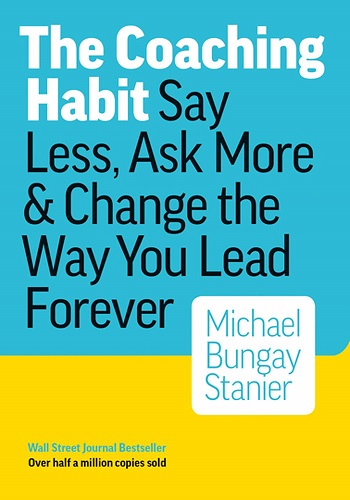Category: Behavioral Change
(63 von 100)
Why: I am a bad listener and want to become better at listening.
Goal: Learn questions that would keep me from my inner Advice-Monster.
Table of Contents
Action: More Asking, and Less Telling.
3 Key Concepts
- Empowering means giving up your power to unlock theirs.
- Answers are closed rooms, and questions are open doors.
- Your advice is not as good as you think it is.
Summary
How to ask more and tell less?
Ask the right questions.
This book gives you 7 questions to ask to become a coach and stay in the land of open doors.
Tell less and ask more.
The key is to build a habit of curiosity.
Your advice is not as good
As you think it is.
Provide a safe place to open up
TERA how brain reads situation
Tribe = “Are you on my side?” Friend or Enemy.
Expectation = “What happens next?” Clear or Unclear.
Rank = “Are you more important than me?” Higher or Lower status.
Autonomy = “Do I get a say here?” Free or Forced.
Raise the TERA quotient with good questions below.
7 Questions/Steps to become a coach
1: Kickstart a conversation
“What’s on your mind?”
Let’s talk about the thing that matters most (to you). It starts a conversation with the right size request, not too broad nor specific. They already have it in their mind = not too awkward to think.
Notice: Facebook uses this question to get users to talk and post more.
Then follow with 3P to choose an element to focus on further conversation
- Project: stay most of the time here.
- People: explore relationship with others when project-based talk stuck.
- Pattern: this is a bit too personal, it is used in development coaching.
2: AWE them to get a whole image
“And what else?”
Aim to exhaust the things on their mind, ask until they say, “There is nothing else.”
There is always more to it than meets the eyes. Keep this in mind, the first thing mentioned is usually just a jab. Practice this question to reap more options that lead to better decisions. And buckle up to listen more, to keep your mouth shut a bit longer.
3: Focus on a real topic
“So, what’s the real challenge here for you?”
After you get them mentioned all the worries, cut through the fog, and get them to choose one important thing to talk about. Knowing that other mentioned facts are just to build up this point.
4: Find the ground
“What do you want?”
This is a KO hook. Goldfish question as they will have bugged eyes, moving mouth, but no words coming out.
It is an adult-to-adult conversation, knowing that you can ask for what you want and at the same time knowing that the answer may be No.
This is the ground of interesting and worthwhile conversation. It gets rid of the illusion that both parties know what the other wants.
5: Stay lazy
“How can I help?”
This forces them to make a clear request. It also saves you from thinking that you know how best to help them and leap into action.
More direct version: “What do you want from me?”
6: Complete the picture
“If you’re saying Yes to this, what are you saying no to?”
This helps clear the wrong assumptions of “wants” and “needs.” It is problematic when we only know wishes and desires, but not the No-no conditions.
A Yes is nothing without the No that gives it boundaries and form.
Michael Bungay Stanier
7: Learn the lesson
“What was most useful to you?”
This is how you finish the conversation looking like a genius.
Learning doesn’t happen when you tell them something or even when they actually do it. Instead, it happens when you give them time to recall and reflect on what just happened.
Ask and wait for answers.
Michael Bungay Stanier
Take 3 breathes.
To sum up, be curious and stay in the land of questions.

ASK, THEN ASK AGAIN.
Goal check: I learned 7 questions to stay curious longer, and this might just work.
Wasu’s Review
( 5.0 / 5.0 )
Get this book on Amazon here!
Bonus: use What questions rather than Why questions in conversation. Why?
- You put them on the defensive. “What the hell are you talking about?”
- You are trying to solve the problem. This leads to not listening, and also unnecessary details.

